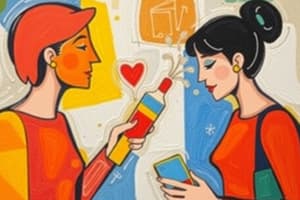Podcast
Questions and Answers
A consumer consistently buys the same brand of coffee beans with minimal thought. This is an example of what type of buying behavior?
A consumer consistently buys the same brand of coffee beans with minimal thought. This is an example of what type of buying behavior?
- Habitual buying behavior (correct)
- Complex buying behavior
- Variety-seeking buying behavior
- Dissonance-reducing buying behavior
Which of the following best describes the 'evaluation of alternatives' stage in the consumer decision process?
Which of the following best describes the 'evaluation of alternatives' stage in the consumer decision process?
- Seeking information from internal and external sources about potential solutions.
- Assessing different options based on gathered information to make a choice. (correct)
- Recognizing a need or want that is not currently being met.
- Experiencing satisfaction or dissatisfaction after using the purchased product.
A company is deciding on a new vendor for office supplies. Which stage of the business buying process involves outlining the required characteristics and quantity of the needed supplies?
A company is deciding on a new vendor for office supplies. Which stage of the business buying process involves outlining the required characteristics and quantity of the needed supplies?
- General need description (correct)
- Problem recognition
- Product specification
- Supplier search
What type of social factor influencing consumer behavior includes the values, beliefs, and customs of an individual's community?
What type of social factor influencing consumer behavior includes the values, beliefs, and customs of an individual's community?
Which of the following is the best example of 'word-of-mouth influence' on consumer behavior?
Which of the following is the best example of 'word-of-mouth influence' on consumer behavior?
A consumer is purchasing a new laptop. They spend considerable time researching different brands, specifications, and reading reviews. Which type of buying decision are they most likely engaged in?
A consumer is purchasing a new laptop. They spend considerable time researching different brands, specifications, and reading reviews. Which type of buying decision are they most likely engaged in?
Which of the following is an example of an organizational factor that influences organizational buying?
Which of the following is an example of an organizational factor that influences organizational buying?
In the stages of the business buying process, what directly follows 'supplier search'?
In the stages of the business buying process, what directly follows 'supplier search'?
A consumer feels uncertain after buying a new car, wondering if they made the right choice. This is an example of:
A consumer feels uncertain after buying a new car, wondering if they made the right choice. This is an example of:
Which of the following illustrates how 'personal income' affects consumer behavior?
Which of the following illustrates how 'personal income' affects consumer behavior?
A consumer sees an advertisement for a new smartphone. This is an example of which stage of the consumer decision process?
A consumer sees an advertisement for a new smartphone. This is an example of which stage of the consumer decision process?
What primarily differentiates business markets from consumer markets?
What primarily differentiates business markets from consumer markets?
Which psychological factor is most closely related to how consumers interpret information they receive from advertising or other sources?
Which psychological factor is most closely related to how consumers interpret information they receive from advertising or other sources?
A buyer decides to purchase a product from a company because of its reputation for environmentally friendly practices. Which factor is primarily influencing their decision?
A buyer decides to purchase a product from a company because of its reputation for environmentally friendly practices. Which factor is primarily influencing their decision?
Which of the following best describes the role of 'opinion leaders' in influencing consumer behavior?
Which of the following best describes the role of 'opinion leaders' in influencing consumer behavior?
Which of the following is an example of e-commerce impacting consumer behavior?
Which of the following is an example of e-commerce impacting consumer behavior?
A consumer is torn between two brands of smartphones that are similar in price and features. They ultimately choose one because a friend highly recommended it. What type of buying behavior is this?
A consumer is torn between two brands of smartphones that are similar in price and features. They ultimately choose one because a friend highly recommended it. What type of buying behavior is this?
What aspect of the marketing mix is most closely associated with conveying a product's value and persuading consumers to buy it?
What aspect of the marketing mix is most closely associated with conveying a product's value and persuading consumers to buy it?
A company modifies its products based on feedback from customer surveys and online forums. Which influence on the consumer decision process is the company addressing?
A company modifies its products based on feedback from customer surveys and online forums. Which influence on the consumer decision process is the company addressing?
When a company purchases a new software system, detailing the technical requirements and functionalities needed is part of which stage of the business buying process?
When a company purchases a new software system, detailing the technical requirements and functionalities needed is part of which stage of the business buying process?
Flashcards
Consumer Behavior
Consumer Behavior
The psychological, social, and physical actions of potential customers as they become aware of, purchase, consume, and provide feedback about products and services.
Motivation (in consumer behavior)
Motivation (in consumer behavior)
The needs and wants that drive consumers to act.
Perception (in consumer behavior)
Perception (in consumer behavior)
How consumers interpret information and make sense of the world.
Learning (in consumer behavior)
Learning (in consumer behavior)
Signup and view all the flashcards
Attitudes (in consumer behavior)
Attitudes (in consumer behavior)
Signup and view all the flashcards
Beliefs (in consumer behavior)
Beliefs (in consumer behavior)
Signup and view all the flashcards
Culture (social factor)
Culture (social factor)
Signup and view all the flashcards
Social Class
Social Class
Signup and view all the flashcards
Reference Groups
Reference Groups
Signup and view all the flashcards
Opinion Leaders
Opinion Leaders
Signup and view all the flashcards
Word-of-Mouth Influence
Word-of-Mouth Influence
Signup and view all the flashcards
Need Recognition
Need Recognition
Signup and view all the flashcards
Information Search
Information Search
Signup and view all the flashcards
Complex Buying Behavior
Complex Buying Behavior
Signup and view all the flashcards
Dissonance-Reducing Buying Behavior
Dissonance-Reducing Buying Behavior
Signup and view all the flashcards
Habitual Buying Behavior
Habitual Buying Behavior
Signup and view all the flashcards
Variety-Seeking Buying Behavior
Variety-Seeking Buying Behavior
Signup and view all the flashcards
Cognitive Dissonance
Cognitive Dissonance
Signup and view all the flashcards
Organizational Buying
Organizational Buying
Signup and view all the flashcards
Order-Routine Specification
Order-Routine Specification
Signup and view all the flashcards
Study Notes
- Consumer behavior encompasses the psychological, social, and physical actions of potential customers as they become aware of, purchase, consume, and provide feedback about products and services.
Psychological Factors
- Motivation relates to the needs and wants that drive consumers to act.
- Perception is how consumers interpret information and make sense of the world.
- Learning involves changes in behavior arising from experience.
- Attitudes are feelings about products or services.
- Beliefs are thoughts that consumers hold about products or services.
Social Factors
- Culture includes the values, beliefs, customs, and tastes valued by a group of people.
- Social class is determined by income, occupation, and education.
- Reference groups directly or indirectly influence a person's attitudes or behavior.
- Opinion leaders influence others because of their expertise, knowledge, or social skills.
- Word-of-mouth influence involves personal communications about products and services between target buyers and neighbors, friends, family, and associates.
Economic Factors
- Personal income affects what consumers can buy.
- Family income influences household spending patterns.
- Consumer spending patterns vary based on economic conditions.
Purchasing Decisions
- Need recognition is the beginning of the buying process, where the consumer recognizes a problem or need.
- Information search involves seeking information about potential solutions.
- Evaluation of alternatives involves assessing different options based on the information gathered.
- Purchase decision is when the consumer decides to buy the product.
- Post-purchase behavior involves evaluating the satisfaction with the purchase.
Types of Buying Decisions
- Complex buying behavior is when consumers are highly involved in a purchase and perceive significant differences among brands.
- Dissonance-reducing buying behavior is when consumers are highly involved with an expensive, infrequent, or risky purchase, but see little difference among brands.
- Habitual buying behavior is when consumers have low involvement and little significant brand difference.
- Variety-seeking buying behavior is when consumers have low involvement but perceive significant brand differences.
The Consumer Decision Process
- Problem recognition occurs when a buyer becomes aware of a difference between a desired state and an actual condition.
- Information search: Consumers seek information about a product.
- Internal search involves recalling information from memory.
- External search involves seeking information from outside sources.
- Evaluation of alternatives involves using information to evaluate different brands in the choice set.
- Purchase decision: The buyer chooses which product to buy.
- Post-purchase evaluation: The consumer evaluates the product after the purchase.
- Cognitive dissonance is buyer discomfort caused by post-purchase conflict.
Influences on the Consumer Decision Process
- Marketing mix factors are product, price, place, and promotion.
- Psychological factors include motivation, perception, learning, attitudes, and beliefs.
- Situational factors include purchase reason, time available, and social surroundings.
- Social factors include culture, social class, reference groups, and family.
Organizational Buying Behavior
- Organizational buying is the decision-making process by which formal organizations establish the need for purchased products and services and identify, evaluate, and choose among alternative brands and suppliers.
- Business markets have fewer customers and suppliers, but larger transactions.
- Business buying involves professional purchasing efforts.
- Business buying decisions are more complex.
Stages of the Business Buying Process
- Problem recognition is when someone in the company recognizes a need.
- General need description describes the characteristics and quantity of the needed item.
- Product specification involves the technical specifications of the item.
- Supplier search involves identifying the right suppliers.
- Proposal solicitation involves requesting proposals from qualified suppliers.
- Supplier selection is when the company reviews proposals and selects a supplier.
- Order-routine specification includes the final order with the chosen supplier and lists the technical specifications, quantity needed, expected time of delivery, return policies, and warranties.
- Performance review involves assessing supplier performance.
Factors Influencing Organizational Buying
- Environmental factors include the economic outlook, technological changes, political developments, and competitive developments.
- Organizational factors include objectives, policies, procedures, organizational structure, and systems.
- Interpersonal factors include influence, expertise, and dynamics.
- Individual factors include job position, motivation, personality, preferences, and buying style.
E-Commerce and Consumer Behavior
- E-commerce has transformed how consumers search for products.
- Online reviews influence consumer purchase decisions.
- Social media marketing impacts consumer brand perceptions.
- Mobile commerce allows consumers to purchase products from anywhere.
Studying That Suits You
Use AI to generate personalized quizzes and flashcards to suit your learning preferences.




